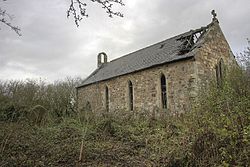Embleton, County Durham: Difference between revisions
Created page with "{{Infobox town |name=Embleton |county=Durham |picture=Former Chapel-of-Ease, Embleton.jpg |picture caption=The ruined church at Embleton |os grid ref=NZ422299 |latitude=54.662..." |
m →top: clean up, replaced: medieval → mediæval (3) |
||
| Line 15: | Line 15: | ||
|constituency= | |constituency= | ||
}} | }} | ||
'''Embleton''' is a hamlet, township and former chapelry, in [[County Durham]], as well as the site of a | '''Embleton''' is a hamlet, township and former chapelry, in [[County Durham]], as well as the site of a mediæval village and manor.<ref name=Ross /> It is situated three miles east of [[Sedgefield]]<ref name=Whellan /> and four miles west of [[Hartlepool]]. | ||
The township was historically named "Elmdene", supposedly derived from the site's proximity to a woodland of elm trees which, at an earlier time, flourished in the bordering dene. A single farmstead now occupies the site which lies adjacent to the ruins of a small church (originally a manorial chapel of ease) dedicated to the Virgin Mary.<ref name=Whellan>{{citation | author=Whellan | year=1856 | title=History, topography, and directory of the county palatine of Durham| publisher=Whittaker and co. | page=520 | url=http://books.google.ca/books?id=vN4MAAAAYAAJ }}</ref> | The township was historically named "Elmdene", supposedly derived from the site's proximity to a woodland of elm trees which, at an earlier time, flourished in the bordering dene. A single farmstead now occupies the site which lies adjacent to the ruins of a small church (originally a manorial chapel of ease) dedicated to the Virgin Mary.<ref name=Whellan>{{citation | author=Whellan | year=1856 | title=History, topography, and directory of the county palatine of Durham| publisher=Whittaker and co. | page=520 | url=http://books.google.ca/books?id=vN4MAAAAYAAJ }}</ref> | ||
From the 13th to the mid-16th century the manor was the seat of the Elmeden family who assumed the local name.<ref name=Ross>{{citation | last1=Mackenzie | first1=Eneas | year=1834 | title=An historical, topographical, and descriptive view of the county palatine of Durham, Volume 1 | last2=Ross | first2=Marvin | publisher=Mackenzie and Dent | page=441 | url=http://books.google.ca/books?id=0ThNAAAAMAAJ }}</ref> The village was one of nearly 1,500 | From the 13th to the mid-16th century the manor was the seat of the Elmeden family who assumed the local name.<ref name=Ross>{{citation | last1=Mackenzie | first1=Eneas | year=1834 | title=An historical, topographical, and descriptive view of the county palatine of Durham, Volume 1 | last2=Ross | first2=Marvin | publisher=Mackenzie and Dent | page=441 | url=http://books.google.ca/books?id=0ThNAAAAMAAJ }}</ref> The village was one of nearly 1,500 mediæval villages to be abandoned in the 14th century after the collapse of the demesne system of land management.<ref>Hodgett, Gerald, (2006) ''A Social and Economic History of Medieval Europe,'' Abingdon, United Kingdom: Routledge, {{ISBN|978-0-415-37707-2}}, p.206.</ref> It afterwards passed in the female line to the Bulmers and Smythes and in the 18th century to the Tempests of Wynyard, ancestors of the Marquesses of Londonderry.<ref>Robert Surtees, ''History of Durham, Vol.III, p.53</ref> | ||
==Outside links== | ==Outside links== | ||
Latest revision as of 11:12, 30 January 2021
| Embleton | |
| County Durham | |
|---|---|
 The ruined church at Embleton | |
| Location | |
| Grid reference: | NZ422299 |
| Location: | 54°39’45"N, 1°20’50"W |
| Data | |
| Post town: | Billingham |
| Postcode: | TS22 |
| Local Government | |
| Council: | County Durham |
Embleton is a hamlet, township and former chapelry, in County Durham, as well as the site of a mediæval village and manor.[1] It is situated three miles east of Sedgefield[2] and four miles west of Hartlepool.
The township was historically named "Elmdene", supposedly derived from the site's proximity to a woodland of elm trees which, at an earlier time, flourished in the bordering dene. A single farmstead now occupies the site which lies adjacent to the ruins of a small church (originally a manorial chapel of ease) dedicated to the Virgin Mary.[2]
From the 13th to the mid-16th century the manor was the seat of the Elmeden family who assumed the local name.[1] The village was one of nearly 1,500 mediæval villages to be abandoned in the 14th century after the collapse of the demesne system of land management.[3] It afterwards passed in the female line to the Bulmers and Smythes and in the 18th century to the Tempests of Wynyard, ancestors of the Marquesses of Londonderry.[4]
Outside links
| ("Wikimedia Commons" has material about Embleton, County Durham) |
References
- ↑ 1.0 1.1 Mackenzie, Eneas; Ross, Marvin (1834), An historical, topographical, and descriptive view of the county palatine of Durham, Volume 1, Mackenzie and Dent, p. 441, http://books.google.ca/books?id=0ThNAAAAMAAJ
- ↑ 2.0 2.1 Whellan (1856), History, topography, and directory of the county palatine of Durham, Whittaker and co., p. 520, http://books.google.ca/books?id=vN4MAAAAYAAJ
- ↑ Hodgett, Gerald, (2006) A Social and Economic History of Medieval Europe, Abingdon, United Kingdom: Routledge, ISBN 978-0-415-37707-2, p.206.
- ↑ Robert Surtees, History of Durham, Vol.III, p.53
- Fordyce, William (1857), The history and antiquities of the county palatine of Durham, Volume 2, A. Fullarton and co., p. 346, http://books.google.ca/books?id=SjhNAAAAMAAJ
- The Post Office Directory Of Durham And Northumberland., 1879, p. 186, http://books.google.ca/books?id=leYNAAAAQAAJ
